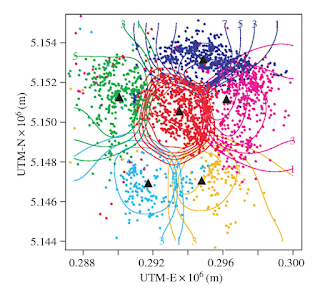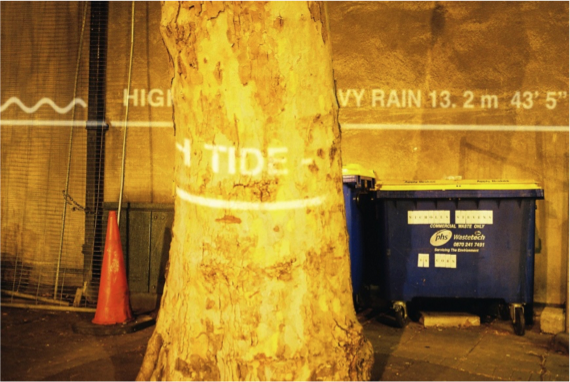Professor Emily Zobel Marshall
It's interesting to look at how Holder's approach is then realised within individual portraits. The portrait of Professor Emily Zobel Marshall is a particularly sensitive combination of the sitter's chosen stance, (hands on hips, staring out into the space she occupies, body very erect and alive with potential) and his application of drawing technique to capture this. Her hair and its interwoven relationship with Holder's approach to the seeking line, became for myself a 'punctum'. (I'm thinking here of Roland Barthes use of the word, whereby he would become attracted to a specific detail in a photograph and this would have a powerful impact on his reaction to the rest of the image.) The fine searching lines of crayon become strands of hair. There is a wonderful synergy between the massing of individual lines and the massing of hair, the one effectively becomes the other, the open energy of the mark making becomes the slightly unruly face framing hairstyle. I am what I am, says both the hair and the crayon mass that represents it. What is then fascinating is how these marks then go on to construct the face.
Rembrandt: Margaretha de Geer
If we look at a Rembrandt portrait, we can see how he treats facial detail, in such a way that we are given a fluidity of emotional engagement, interwoven with a fluidity of paint. Bone structure is clearly in place, but the paint flows over it, in effect therefore forever animating our relationship with the sitter, who is always coming into being, the paint never settling down and therefore remaining alive. The dark space of Rembrandt takes us into an awareness of the sitter's deep psychological inner world, while the interlacing lines of Holder's drawings emerge out of white paper and vibrate with an energy that suggests a more lively inner state, one that in the professor's case is reflected in her stance, suggestive of action, and a confrontation with the light of day, rather than an interiority moving back into the dark.
Background detail: Professor Emily Zobel Marshall
In the space around Emily Zobel Marshall flowers are growing. These echo the ones on her dress, which have been reinforced by the use of acrylic gouache. By being liberated from the dress fabric they appear to grow out of her body, perhaps ghosts of an idea she might once have had. they are made out of the same red crayon lines that she emerges from, an earlier form that like a fossil tells us much about the past. As my gaze flits back to the face, the line of a cheek bone reasserts itself, a sign of a firm skull underneath the soft woven texture of line mass. Her dress has red flower heads painted into the line matrix, this change of media, changing the speed of read, making this fabric more of a holding frame for a body standing proud. Her lips are firm but perhaps, because of the moving lines within which they sit, they are also on the edge of a tremble, after all, the lines of dancing rhythm, like all tricksters, never do quite stand still, they never do create unyielding solids, and as they search the figure out, they perhaps also reveal something of a person's fragility as much as their solidity.
Because I know Doctor Rommi Smith the poet, performer and writer, I wanted to see how Curtis had managed to depict such a dynamic character.
Doctor Rommi Smith
The first thing you notice is that she has many hands. Constantly moving hands create waves of flowing energy around her. In the drawing she has three heads and all revolve around the yellow V of her shirt front, or is it a blouse? Unlike the Emily Zobel Marshall portrait, Rommi's body does not extend down to the bottom of the image, it dissolves in a swirl of marks, as if the waving hands are also breaking her image apart, wiping it away as they gesticulate her thoughts, or try to reinforce an utterance. The hands become like birds about to fly away and have their own independent lives, an idea that could only emerge from a drawing technique that uses marks that flow so fluidly over and through the spaces of the white paper. These intermeshing lines opening out the types of spaces perhaps only seen by birds as they fly through a thick set hedge.

In the portrait of Rommi, arising out of the mazy energy of the crayons' application, there is a strong suggestion of spirituality. This is reinforced by the slightly upwards gazing head, a gaze that looks inwards as much as out. There is a tap on the chest given by the one hand framed in black, a tap that says, "Yes its me, I'm here", the central figure trying to reassure us that she is the one we need to listen to, not those others half formed in the background, not those ghosts of past selves.
In this portrait the punctum for myself was the one line that dropped down from the drawing to touch its bottom edge. A spindly line that the whole drawing is balanced on. Suddenly I became aware that underneath all Rommi's swirling energy, fierce pride and powerful intelligence, there was a thin line that somehow held it all together and that she was more fragile than I had thought.
Rommi Smith: detail
It is Holder's technique that lends itself to these types of narrative. The flickering marks will always suggest a certain fragility, their smoke like haziness can so easily be read with some sort of spiritual implication, but therein lies the fascination of the technique and its need for careful control. The drawer has to finally establish enough coherence within the matrix of lines to convince the audience that some sort of likeness is emerging, not perhaps a fixed likeness, but one that still looks how the sitter appears. This is a likeness as a verb rather than as a noun, a capturing of moments, rather than a moment, which for myself is far more incisive than a photographic copy. It is only in conversation that we get to know someone. In my own work I prioritise conversations as a way to find out what others think and feel, and sometimes these conversations also become portraits, very different in feel and ability to the work of Curtis Holder, but they have given me enough of a similar experience to know how important the one to one experience is to the creation of a necessary empathy if a portrait is to have any real conviction.
Alongside the room of large scale 'finished' portraits which were excellently framed and set off against a wonderful dark blue is a room devoted to Holder's small studies. This room is essential viewing if you are to get a feel for the full range of his ability.
Curtis Holder: Study
I was particularly taken by a small study of a seated man. It reminded me of my old colleague Peter. He has recently had a wonderful exhibition of his photographs, some of which occupied the same space as the drawing I was looking at. Whether it was of him or not doesn't really matter, because the drawing says things about the human condition as a whole, which is why I think Curtis is such an important artist. His drawings go beyond portraiture, they signify something in their very nervous search for truth, that says things about how fragile and yet full of energy life is. The image of a seated man tells us that whoever it was sat for a while had a very particular life force, one expressed through their face, their hands and their body as much as their words. My only reservation about the display was the use of the square magnets, a device that stops holes being put into the paper, but which visually intrudes into the paper space. Such fragile and sensitive marks need to be read unimpeded by any other visual interference. On the other hand it was a brave act to not put these drawings under the cover of perspex sheets and by doing this I really appreciated the close proximity this gave to the act of their making.
The exhibition is open from 08 November, 2024 until 13 April, 2025 and if you can get there don't miss the Stuart Croft exhibition that is on at the same time, the films are extraordinary and deeply thought provoking, this is an excellent time to visit.
See also:








































.jpg)